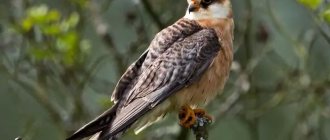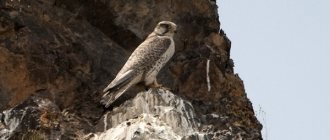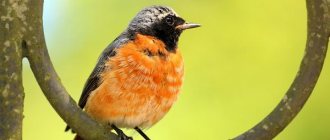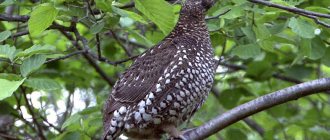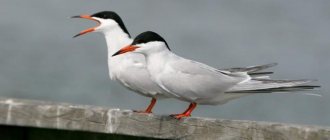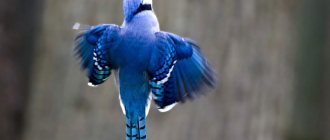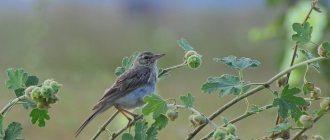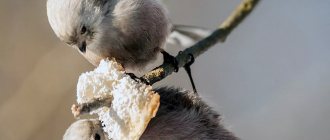- Wild animals
- >>
- Birds
A small but swift and agile hobbyhorse , like a miniature falcon. His appearance immediately reveals the nobility of a falcon and his predatory nature. The deep, keen, bird-like gaze captivates and intrigues, and the beautiful swift flight gives a feeling of freedom and weightlessness. Let's study this amazing feathered creature in more detail, describing its appearance, character, features of its lifestyle and favorite places of deployment.
Origin of the species and description
Photo: Cheglok
Hobby is a feathered predator from the falcon family, belonging to the order Falconiformes and the genus Falcons. Externally, the hobby is very similar to the falcon, but in reduced size. There are several similar species belonging to the same genus, which have the word “hobby” in their names; they are even combined into a separate group called Hypotriorchis. Among the common characteristic features of this group are the dark gray color of the plumage, the presence of black “whiskers” and streaks on the abdominal part, which are located along the body.
Video: Hobby
The first to describe this species of bird was the Swedish scientist, physician and naturalist Carl Linnaeus, this happened in 1758. The name of the genus “falcons” in Latin sounds like “falco” and translated means “sickle”, which is directly related to the curved talons of all falcons. The meaning of the word “hobby” is still not fully understood. Employees of the Moscow Pedagogical State University believe that the name of the bird comes from the Old Russian “chegl”, which means “genuine, original”.
There is an assumption that this value indicates that this bird is classified as a falcon bird of prey - the gyrfalcon, peregrine falcon, which are characterized by smaller dimensions compared to falcons. The Hobby, therefore, is opposed to such medium-sized falcons as the falcon and kestrel, which were not previously used for hunting.
Hobby is a tireless hunter and predator of noble blood. It is easy to confuse it with the peregrine falcon; the differences are in size (the peregrine falcon is larger), longitudinal streaks on the belly (in the peregrine falcon they are transverse) and the reddish tint of the limbs. Hobby males are slightly smaller than females, their weight varies from 160 to 200 grams, and their body length is from 32 to 35 cm. Females weigh from 230 to 250 grams and have a length from 33 to 37 cm.
Description of Eleanor's Falcon
This representative of falcons is slightly larger in size than the peregrine falcon and slightly smaller than the usual hobby. The bird reaches a length of 36 to 42 cm. The weight of Eleanor's Hobby can vary from 280 to 400 g. The wingspan of this species is larger than that of an ordinary Hobby and ranges from 87 to 104 cm.
There are two main types of colors of the Eleanor's Falcon. About 70 percent of the population consists of birds with “light” plumage and about 30 percent have “dark” plumage. It is difficult to identify the sex of a Hobby of this species, and the color of the bird is also not helpful in this regard and does not depend on the sex or age of the bird. However, it should be noted that the male is slightly smaller in size than the female.
Birds with a light morph are similar to the common Hobby, but differ from it in the presence of fluffy plumage around the legs, which resembles “pants.” The species we are considering has brown plumage, with a rich red tint.
In the second species of falcons, the color of almost the entire body is dark brown, sometimes fading into black.
Eleanor's Hobby in dark color
Appearance and features
Photo: Hobby bird
The head of the Hobby is neat, has a rounded shape, and the sharp, large, round, expressive eyes of a dark brown color are clearly visible on it. The bird's beak cannot be called powerful; it is not large. The tarsus of the bird are also small, covered with feathers on top. The paws are equipped with thin, but extended and tenacious fingers. In general, the Hobby looks quite elegant, distinguished by long wings protruding beyond the tip of the tail. And its tail is long and wedge-shaped.
The color of the Hobby's plumage is variable, depending on its age. Male and female individuals are almost identical in appearance, so it is difficult to distinguish them. In infancy, the predominant color is white, which persists in the chicks until they are two weeks old. Then gray specks and an ocher tone appear in the robe in the abdomen area. As the month approaches, the color becomes more pronounced. On the back, brown feathers are indicated; in the head area and on the abdominal part, shades of ocher color predominate; only a longitudinal pattern is noticeable on the belly. The beak has a grayish-black tone with a bluish tint at the base. The pale yellow paws have dark, hook-shaped claws.
Interesting fact: In the second year of life, the bird's suit has a brown top, the bluish tones in it gradually disappear, the undertail and shin area acquire the same color as those of mature birds.
It should be noted that when the feather color of the Hobby wears out, a certain bluish tone disappears. Whitish streaks stand out on the back of the head and neck of the bird. The imitation mustache is painted black (dark stripes under the eyes). On the sides, chest and belly the feathers are white with oblong wide streaks of dark shades. A reddish tint appears in the area of the undertail and shins. It seems that the hobby is wearing red trousers. The female has brown specks on the red background, which are also present on the inside of the wings.
Hobby. Birds of Brateevograd. Video (00:01:02)
Hobbies are rarely observed in Brateevo and Maryino. He settles in old hooded crow nests on power transmission poles across the Maryinsko-Brateevskaya floodplain. The Hobby also appeared on the territory of the Brateevsky Cascade Park, where sparrows and coniferous trees were preserved. Flies after sparrows into the courtyards of residential buildings up to Borisovskie Prudy Street. A flock of Hobbies was spotted by observant fishermen in the forested coastal zone of the Moscow River in the area of the old pier at the turn to the conversations. They grazed there from spring until late autumn. It is unknown where they hid for the winter. And in the ravine of the dried-up Plintovka stream they saw Hobby nests.
Where does the Hobby live?
Photo: Hobby in flight
Hobby has taken a fancy to Eurasia and North Africa, occupying quite vast areas there.
It should be noted that this bird is found on almost all continents; the bird inhabits:
- Finland;
- Japan;
- Russia;
- Vietnam;
- Himalayas;
- Sakhalin;
- Kuril and British Islands;
- Tunisia;
- Morocco;
- Spain;
- Asia Minor;
- Mongolia;
- Greece;
- Italy.
Hobby prefers light forest areas, giving way to open steppe areas suitable for hunting. It establishes its nesting sites in almost the entire forest area of the former Soviet Union, with the exception of the northern part of the taiga. This bird avoids South Asia, the tropical forests of western Africa, China and India.
Interesting fact: The Hobby nests in sparse forests, preferring to live either in mixed areas or in tall, old pine forests.
The Hobby does not like either completely open areas or dense, impassable thickets. He can choose a forest edge, a river bank, or the edge of wetlands. There are known facts of this bird settling near human dwellings, but this is very rare; the bird prefers to avoid close contact with people, maintaining neutrality. In mountainous areas you can also find the Hobby, which climbs up to 4 km in height, where it feels great. If we talk about the varieties of these birds, we can note their habitat, which is characteristic of each species.
Scientists have identified only a couple of subspecies of Hobby, these are:
- falco subbuteo subbuteo Linnaeus, inhabiting Europe, northwest Africa and all parts of Asia except southeast. This subspecies is considered migratory; for wintering it chooses South Asia and Central and Southern Africa;
- falco subbuteo streichi Hartert und Neumann, found in Southeast Asia, is a sedentary subspecies.
Now you know where the Hobby lives. Let's see what this bird of prey eats.
Range, habitats
Hobby chooses to live in light forests with spacious open landscapes for hunting. It can nest in almost the entire forest territory of the former USSR. The exception is considered to be the taiga (its northern sections). This falcon can also be found in Italy, the countries of Western Europe and Asia Minor, Spain, Mongolia, Asia and Greece. Hobbies do not live in South Asia, the tropical forest zone of West Africa, India and China.
This is interesting! The small falcon chooses sparse forests for nesting. Preferred species are mixed or old tall pine forests.
It can be seen on the edge of a forest, on the outskirts of a sphagnum bog, on the banks of a large river, in a pasture near agricultural land. The Hobby avoids the continuous dark taiga and areas devoid of trees.
Return to content
What does the hobby eat?
Photo: Cheglok in Russia
Hobby is a dexterous and tireless hunter, making swift air attacks. Its menu is dominated by small birds and large insects. As for insects, the Hobby can snack on various beetles, butterflies, and dragonflies. The avian victims of the Hobby are often common sparrows, starlings, and wagtails. The feathered predator often settles near the nesting sites of black swifts and swallows, which it also likes to eat as a snack.
The Hobby conducts its vigilant hunting in the evening hours, when twilight approaches, so it often comes across bats, which also become an excellent dinner. The virtuoso predator catches its prey during a fast and coordinated flight, grabbing it right in the air. He is very skillful, persistent and impetuous, so he is able to catch up with any snack that interests him.
If the prey, by the standards of the Hobby, is quite weighty, then it carries it to a nearby tree, where it eats its meal in the branches. The predator swallows insects while in flight. Sometimes small rodents and lizards slip into the hobby's diet, but such prey can be called purely random, because hunting is carried out in the air, because catching ground prey is very difficult for birds.
Nutrition
The Hobby's main diet consists of small birds and insects. Its most common prey are beetles, butterflies and dragonflies. Prefers starlings and sparrows as birds. At night, bats can become its victims. Prefers to live near the habitat of swallows and swifts. It is extremely rare that they can feed on mice and small earthly inhabitants. Hunt in flight.
Features of character and lifestyle
Photo: Hobby bird in nature
Hobbies can be called very mobile, active and restless. In addition, he has a very cool, cocky and stubborn disposition. He treats any other birds with hostility, even his closest relatives. His aggression is not due to the fact that there is little food, he just has such a fighting and not very friendly character. Birds that fly up to the Hobby's nesting area will certainly not be in any good health.
Interesting fact: Having noticed another bird nearby, the Hobby immediately starts a fight with it. Small birds are immediately considered by the Hobby as a snack. Of course, he won’t be able to catch everyone, but he will make enormous efforts to do this.
The stern, piercing gaze and angry “mustaches” make the appearance of the Hobby slightly threatening and very serious. The Hobby, which has settled near gardens and cultivated lands, provides a great service to people by eating small birds that peck away the crop. The feathered one allocates itself a territory for hunting, which it jealously protects from any uninvited flying guests. Typically, there is a neutral zone between hobby patches. The hunt takes place completely alone at a considerable altitude. The flight of the Hobby is swift and agile, with rapid flapping of the wings giving way to smooth gliding movements. It should be noted that soaring is not typical for these birds; in flight, the outstretched wings of the Hobby resemble a sickle.
Ornithologists have found that nature has endowed hobby birds with extraordinary vigilance, so any insect within two hundred meters cannot hide from a predator. The Hobby cannot be called talkative; on the contrary, it is very silent. Only his excessive anxiety is sometimes accompanied by a rather sharp, abrupt and deafening cry, typical of the entire falcon family.
Social structure and reproduction
Photo: Cheglok
The wedding season for Hobbies falls at the end of April - beginning of May. During this stormy time for birds, you can see feathered pairs circling in the air, where they perform various tricks and maneuvers. During such romantic dances, caring hobbyhorses can treat each other right in flight, this is how they express their affection and sympathy for their partner.
Hobbies do not build their nests; they lay eggs in empty nests of other birds, and sometimes unceremoniously evict birds from a place they like. Hobbies look for nests located high from the ground.
The process of choosing a nest is quite scrupulous; a number of factors are taken into account:
- the presence of a nearby water source (river, stream);
- location in the nesting area of a wooded thicket;
- the presence of nearby open spaces of fields or meadows necessary for hunting.
A married couple of Hobbies carefully guards their favorite territory from other birds, viewing it from a nest located at a high altitude (from 10 to 30 meters). The female begins the process of laying eggs either at the very end of May or in July, it all depends on the ambient temperature. The nest can contain from three to six eggs, the sizes of which vary from 3 to 3.6 cm. The incubation period lasts within one month. All this time, the female warms the eggs with her body, and the future father brings her food.
Newborn chicks are not similar in appearance to their parents, they are covered with a rare layer of white fluff, which is why they so need maternal warmth at first; the father has to hunt alone, feeding both the children, the partner, and himself. The little ones grow up quickly, get stronger and gain weight. Soon they undergo the first molting process and already at the age of one month begin to fly independently. At first, the young animals lack dexterity and agility, so their caring ancestors feed them all the time.
Throughout the summer, Hobbies live in a friendly large family. Only with the arrival of autumn do mature young people set off towards adulthood, leaving their nests and rushing to wintering places. It is worth adding that hobby birds can be considered long-lived birds, because nature has endowed them with a considerable life span, ranging from 17 to 20 years, but this is not the limit. There is information about Hobbies that lived for a quarter of a century.
Mating season
The mating games begin with the end of spring. During the flight, the male usually gives the caught food to the chosen female. And their mating dances fascinate with the difference in graceful whirling and pirouettes. During such a joint dance, they can dive down, clinging with their claws.
Hobbies do not build a nest on their own , so for laying they choose a ready-made place created by a crow or magpie. A pair of birds work together to protect the nest and the surrounding area. They spend a lot of effort and time on this. They constantly patrol the space and drive away absolutely all potential enemies. Often these birds create a strong pair for many years.
Eggs are laid in summer. There are usually from 3 to 6 eggs in a clutch. They are small in size, brown or yellow with a red dot. The eggs are incubated by the female, and the male provides her with food and protection. After 3 weeks, shaggy and light-colored chicks begin to hatch. Now both birds are engaged in feeding and caring for the offspring. They alternately fly after prey and spend the entire daylight hours hunting . Mature birds fly out of the parental nest after 7 - 9 weeks.
If potential enemies, such as hawks, settle nearby with a couple of birds. Because of their quarrelsome temper, Hobbies start a war with their neighbors and get so carried away by the process that they sometimes forget why the pair was actually created and the nest was chosen.
Natural enemies of Hobbies
Photo: Hobby bird
Despite the fact that the Hobby is a small bird, it has practically no enemies in the wild. Apparently, this happens for several reasons. Firstly, the bird is almost always out of reach, its nesting site is located very high, and the hobby itself spends a large amount of time in the air.
Secondly, we should not forget that this is, first of all, a predator and it has a courageous and purposeful nature. Thirdly, the hobbyhorse’s character is not a gift. His impudent, cocky and unfriendly disposition scares off many ill-wishers. Fourthly, one should not underestimate the resourcefulness, swiftness, excessive activity and dexterity of this bird.
Interesting fact: Hobbies use trains as assistants in their hunt. Their flight speed can exceed moving trains. Flying after him, the hobby catches birds, which the roar of the train forces to rise from secluded places.
In the clutches of some ill-wishers, most often, those who are weakened by illness, very elderly birds or inexperienced young animals end up. The Hobby remains neutral with people, preferring not to have close contact. But humans, nevertheless, can be counted among the enemies of this proud bird, because he indirectly influences its life when he invades places of permanent deployment, displaces birds from inhabited territories, conducts endless economic activities, cuts down forests, and worsens the environmental situation in general. All these actions adversely affect the life of the Hobby, as well as any other representatives of wild fauna.
INTERESTING FACTS, INFORMATION…
- The silhouette and coloration of the Hobby resembles a miniature peregrine falcon. However, it does not have transverse stripes on its chest.
- Sometimes the Hobby hunts on clear moonlit nights.
- The hobby cap is not suitable for falconry. The main reason is that it does not hunt large birds like its large and powerful relatives, such as the peregrine falcon.
- Often, thanks to its high flight speed and extraordinary dexterity, the Hobby takes prey (including small rodents) from kestrels, owls and other feathered predators. Previously, scientists believed that Hobbies hunted only in the air, but this is not so.
- Hobbies use some nesting sites for 30 years or more.
